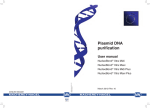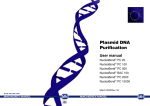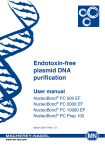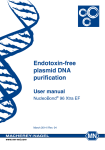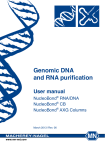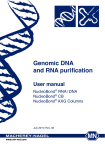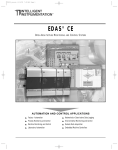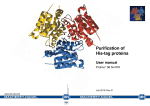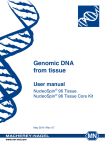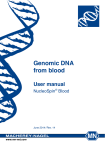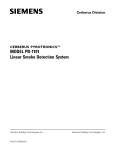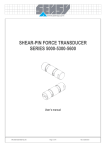Download NucleoBond® PC - MACHEREY
Transcript
Plasmid DNA purification User manual NucleoBond® PC 20 NucleoBond® PC 100 NucleoBond® PC 500 NucleoBond® BAC 100 NucleoBond® PC 2000 A025744 R09en1/4/0/11.11 Printed in Germany NucleoBond® PC 10000 www.mn-net.com MACHEREY-NAGEL November 2011 / Rev. 09 MACHEREY-NAGEL MACHEREY-NAGEL MN EN ISO 9001: 2008 CERTIFIED Plasmid DNA Purification (Mini, Midi, Maxi, Mega, Giga) Protocol-at-a-glance (Rev. 09) 1 Cultivate and harvest bacterial cells 2 Cell lysis Mini Midi Maxi Mega Giga (AX 20) (AX 100) (AX 500) (AX 2000) (AX 10000) 4,500–6,000 x g 4 °C, 15 min 4,500–6,000 x g 4 °C, 15 min 4,500–6,000 x g 4 °C, 15 min 4,500–6,000 x g 4 °C, 15 min 4,500–6,000 x g 4 °C, 15 min High copy / low-copy Buffer S1 0.4 mL / 0.8 mL 4 mL / 8 mL 12 mL / 24 mL 45 mL / 90 mL 120 mL / – Buffer S2 0.4 mL / 0.8 mL RT, < 5 min 4 mL / 8 mL RT, < 5 min 12 mL / 24 mL RT, < 5 min 45 mL / 90 mL RT, < 5 min 120 mL / – RT, < 5 min Buffer S3 0.4 mL / 0.8 mL 0 °C, 5 min 4 mL / 8 mL 0 °C, 5 min 12 mL / 24 mL 0 °C, 5 min 45 mL / 90 mL 0 °C, 5 min 120 mL / – 0 °C, 5 min Buffer N2 1 mL Buffer N2 2.5 mL Buffer N2 6 mL Buffer N2 20 mL Buffer N2 100 mL Centrifugation Folded Filter or centrifugation Folded Filter or centrifugation Folded Filter or centrifugation Folded Filter or centrifugation 12,000 x g 15 min 12,000 x g 25 min 12,000 x g 40 min 12,000 x g 50 min 12,000 x g 60 min Load cleared lysate onto the column Load cleared lysate onto the column Load cleared lysate onto the column Load cleared lysate onto the column Load cleared lysate onto the column Buffer N3 Buffer N3 Buffer N3 Buffer N3 Buffer N3 High copy 2 x 1.5 mL High copy 10 mL High copy 32 mL High copy 2 x 35 mL High copy 2 x 100 mL Low copy 2 x 2 mL Low copy 12 mL Low copy 2 x 18 mL Low copy 2 x 50 mL Buffer N5 1 mL Buffer N5 5 mL Buffer N5 15 mL Buffer N5 25 mL Buffer N5 100 mL Isopropanol 0.75 mL Isopropanol 3.5 mL Isopropanol 11 mL Isopropanol 18 mL Isopropanol 70 mL ≥ 15,000 x g ≥ 15,000 x g ≥ 15,000 x g ≥ 15,000 x g ≥ 15,000 x g 70 % ethanol 500 μL 70 % ethanol 2 mL 70 % ethanol 5 mL 70 % ethanol 7 mL 70 % ethanol 10 mL ≥ 15,000 x g ≥ 15,000 x g ≥ 15,000 x g ≥ 15,000 x g ≥ 15,000 x g 5–10 min 5–10 min 10–20 min 30–60 min 30–60 min Appropriate volume of TE Appropriate volume of TE Appropriate volume of TE Appropriate volume of TE Appropriate volume of TE 3 Equilibration of the column 4 Clarification of the lysate 5 Binding 6 Washing 7 Elution 8 Precipitation 4 °C, 30 min 9 Wash and dry DNA pellet RT, 10 min 10 Reconstitute DNA 4 °C, 30 min RT, 10 min 4 °C, 30 min RT, 10 min 4 °C, 30 min RT, 10 min MACHEREY-NAGEL GmbH & Co. KG · Neumann-Neander-Str. 6–8 · 52355 Düren · Germany Tel.: +49 24 21 969-270 · Fax: +49 24 21 969-199 · [email protected] · www.mn-net.com 4 °C, 30 min RT, 10 min Plasmid DNA purification Table of contents 1 Components 5 1.1 Kit contents 5 1.2 Reagents and equipment to be supplied by user 2 Introduction 10 11 2.1 Properties 11 2.2 About this user manual 12 3 Product description 13 3.1 The basic principle 13 3.2 Kit specifications 13 3.3 Buffer compositions 14 3.4 High- / low-copy plasmid purification 15 3.5 Filtration of the lysate 16 3.6 Elution procedure 17 4 Storage conditions and preparation of working solutions 5 Safety instructions 18 19 5.1 Risk and safety phrases 19 5.2 GHS classification 20 6 Growing of bacterial cultures 22 6.1 General considerations 22 6.2 Selection of culture media 23 6.3 Difficult-to-lyse strains 23 6.4 Chloramphenicol amplification of low-copy plasmids 23 7 NucleoBond® plasmid purification 24 7.1 General procedure 24 7.2 High-copy plasmid purification (Mini, Midi, Maxi) 24 7.3 High-copy plasmid purification (Mega, Giga) 27 7.4 Low-copy plasmid purification (Mini, Midi) 30 7.5 Low-copy plasmid purification (Maxi / BAC, Mega) 33 MACHEREY-NAGEL – 11 / 2011, Rev. 09 3 Plasmid DNA purification 8 Appendix 36 8.1 Determination of DNA yield and quality 4 36 8.2 Troubleshooting 36 8.3 Ordering information 43 8.4 References 44 8.5 Product use restriction / warranty 45 MACHEREY-NAGEL – 11 / 2011, Rev. 09 Plasmid DNA purification 1Components 1.1 Kit contents NucleoBond® PC 20 20 preps 100 preps REF 740571 740571.100 Resuspension Buffer S1 25 mL 2 x 25 mL Lysis Buffer S2 25 mL 2 x 25 mL Neutralization Buffer S3 25 mL 2 x 25 mL Equilibration Buffer N2 25 mL 125 mL Wash Buffer N3 3 x 30 mL 3 x 125 mL Elution Buffer N5 32 mL 120 mL RNase A (lyophilized)* 2.5 mg 2 x 2.5 mg NucleoBond® AX 20 Columns 20 100 Plastic Washers 10 10 User Manual 1 1 * For preparation of working solutions and storage conditions see section 4. MACHEREY-NAGEL – 11 / 2011, Rev. 09 5 Plasmid DNA purification 1.1 Kit contents continued NucleoBond® PC 100 20 preps 100 preps REF 740573 740573.100 Resuspension Buffer S1 100 mL 500 mL 4 x 25 mL 500 mL Neutralization Buffer S3 100 mL 500 mL Equilibration Buffer N2 70 mL 2 x 150 mL Wash Buffer N3 250 mL 1000 mL 125 mL Elution Buffer N5 120 mL 3 x 200 mL RNase A (lyophilized)* 10 mg 50 mg NucleoBond® AX 100 Columns 20 100 NucleoBond® Folded Filters 20 100 Plastic Washers 10 10 User Manual 1 1 Lysis Buffer S2 * For preparation of working solutions and storage conditions see section 4. 6 MACHEREY-NAGEL – 11 / 2011, Rev. 09 Plasmid DNA purification 1.1 Kit contents continued NucleoBond® PC 500 10 preps 25 preps 50 preps 100 preps REF 740574 740574.25 740574.50 740574.100 Resuspension Buffer S1 150 mL 2 x 200 mL 2 x 400 mL 3 x 500 mL Lysis Buffer S2 150 mL 400 mL 2 x 400 mL 3 x 500 mL Neutralization Buffer S3 150 mL 400 mL 2 x 400 mL 3 x 500 mL Equilibration Buffer N2 70 mL 200 mL 2 x 200 mL 500 mL 200 mL Wash Buffer N3 2 x 250 mL 1000 mL 2 x 1000 mL 3 x 1000 mL 500 mL Elution Buffer N5 200 mL 500 mL 2 x 500 mL 3 x 500 mL 200 mL RNase A (lyophilized)* 15 mg 2 x 25 mg 2 x 40 mg 3 x 50 mg NucleoBond® AX 500 Columns 10 25 50 100 NucleoBond® Folded Filters XL 10 25 50 100 Plastic Washers 5 10 10 10 User Manual 1 1 1 1 * For preparation of working solutions and storage conditions see section 4. MACHEREY-NAGEL – 11 / 2011, Rev. 09 7 Plasmid DNA purification 1.1 Kit contents continued NucleoBond® PC 2000 NucleoBond® PC 10000 5 preps 5 preps REF 740576 740593 Resuspension Buffer S1 250 mL 750 mL Lysis Buffer S2 250 mL 750 mL Neutralization Buffer S3 250 mL 750 mL Equilibration Buffer N2 125 mL 500 mL 125 mL Wash Buffer N3 2 x 250 mL 1000 mL 125 mL Elution Buffer N5 200 mL 500 mL 120 mL RNase A (lyophilized)* 25 mg 80 mg NucleoBond® AX 2000 Columns 5 – NucleoBond® AX 10000 Columns – 5 NucleoBond® Folded Filters XL 5 – NucleoBond® Folded Filters Type 1 – 10 NucleoBond® Folded Filters Type 2 – 10 Plastic Washers 5 – User Manual 1 1 * For preparation of working solutions and storage conditions see section 4. 8 MACHEREY-NAGEL – 11 / 2011, Rev. 09 Plasmid DNA purification 1.1 Kit contents continued NucleoBond® BAC 100 10 preps REF 740579 Resuspension Buffer S1 2 x 150 mL Lysis Buffer S2 2 x 150 mL Neutralization Buffer S3 2 x 150 mL Equilibration Buffer N2 70 mL Wash Buffer N3 2 x 250 mL Elution Buffer N5 150 mL RNase A (lyophilized)* 2 x 15 mg NucleoBond® BAC 100 Columns 10 NucleoBond® Folded Filters XL 10 Plastic Washers 5 User Manual 1 * For preparation of working solutions and storage conditions see section 4. MACHEREY-NAGEL – 11 / 2011, Rev. 09 9 Plasmid DNA purification 1.2 Reagents and equipment to be supplied by user Reagents • Isopropanol (room-temperatured) • Ice • • 70 % ethanol (room-temperatured) Buffer for reconstitution of DNA (e.g., TE buffer or sterile H2O) Equipment • • • • • 10 Standard microbiological equipment for growing and harvesting bacteria (e.g., inoculating loop, culture tubes and flasks, 37 °C shaking incubator, and centrifuge with rotor and tubes or bottles for harvesting cells) Funnels to hold the NucleoBond® Folded Filters for lysate filtration (NucleoBond® PC 100, 500, 2000, 10000, BAC 100) NucleoBond® Rack (see ordering information) or equivalent holder Refrigerated centrifuge capable of reaching ≥ 15,000 x g with rotor for the appropriate centrifuge tubes or bottles Centrifugation tubes or vessels with suitable capacity for the volumes specified in the respective protocol MACHEREY-NAGEL – 11 / 2011, Rev. 09 Plasmid DNA purification 2Introduction 2.1Properties NucleoBond® AX is a patented silica-based anion-exchange resin, developed by MACHEREY-NAGEL, for routine separation of different classes of nucleic acids. NucleoBond® AX Resin forms the basis for the entire line of nucleic acid purification products presented in this User Manual. NucleoBond® AX Resin consists of hydrophilic, macro porous silica beads coupled to a methyl-ethylamine functional group. The functional group provides a high overall charge density that permits the negatively charged phosphate backbone of plasmid DNA to bind with high specificity to the resin. Due to a specialized manufacturing process that is rigorously controlled and monitored, the beads are uniform in diameter and contain particularly large pores. These special properties allow for optimum flow rates through the column and more efficient binding of nucleic acids to the matrix. Thus, using the matrix you can achieve sharp, well-defined elution profiles for individual nucleic acid species (see Figure 1). NucleoBond® AX can separate distinct nucleic acids from each other and from proteins, carbohydrates, and other unwanted cellular components. The purified nucleic acid products are suitable for use in the most demanding molecular biology applications, including transfection, in vitro transcription, automated or manual sequencing, cloning, hybridization, and PCR. Plasmid DNA, large constructs Compound class Single-stranded DNA, Double-stranded DNA mRNA, 16S/23S rRNA 5S rRNA tRNA tRNA Absorbance at 260 nm rRNA Plasmid DNA, large constructs Proteins, dyes, polysaccharides, metabolites, trinucleotides 0 0.5 1 1.5 Salt concentration for elution [M (KCl)] Figure 1: Elution profile of NucleoBond® AX Resin at pH 7.0 The more interactions a nucleic acid can form between the phosphate backbone and the positively charged resin the later it is eluted with increasing salt concentration. Large nucleic acids carry more charges than short ones, double stranded DNA more than single stranded RNA. MACHEREY-NAGEL – 11 / 2011, Rev. 09 11 Plasmid DNA purification 2.2 About this user manual It is strongly recommended reading the detailed protocol sections of this user manual if the NucleoBond® Plasmid kit is used for the first time. Experienced users, however, may refer to the Protocol-at-a-glance instead. The Protocol-at-a-glance is designed to be used only as a supplemental tool for quick referencing while performing the purification procedure. All technical literature is available on the internet at www.mn-net.com. The protocols in this manual are organized as follows: The volumes of the respective buffers used for a particular column size are high-lighted. Each procedural step is arranged like the following example (taken from section 7.2 High-copy plasmid purification): 1 Mini Midi Maxi (AX 20) (AX 100) (AX 500) Carefully resuspend the pellet of bacterial cells in Buffer S1 + RNase A. Please see section 6.3 regarding difficult-to-lyse strains. 0.4 mL 4 mL 12 mL For example, if you are performing a Mini prep to purify plasmid DNA you will find volumes or incubation times in the white boxes. The name of the buffer, buffer volume, incubation times, repeats, or important handling steps are emphasized in bold type within the instruction. Additional notes or optional steps are printed in italic. In the example shown above the pellet of the bacterial cells has to be resuspended in 0.4 mL of Buffer S1 when performing a Mini prep using NucleoBond® AX 20 Columns, in 4 mL of Buffer S1 when performing a Midi prep using NucleoBond® AX 100 Columns, and in 12 mL of Buffer S1 when performing a Maxi prep using NucleoBond® AX 500 Columns. 12 MACHEREY-NAGEL – 11 / 2011, Rev. 09 Plasmid DNA purification 3 Product description 3.1 The basic principle NucleoBond® PC / BAC kits employ a modified alkaline /SDS lysis procedure to prepare the bacterial cell pellet for plasmid purification. Both chromosomal and plasmid DNA are denatured under these alkaline conditions. Potassium acetate is then added to the denatured lysate, which causes the formation of a precipitate containing chromosomal DNA and other cellular compounds. The potassium acetate buffer also neutralizes the lysate. Plasmid DNA can revert to its native supercoiled structure and remains in solution. After equilibrating the appropriate NucleoBond® Column with equilibration buffer, plasmid DNA is bound to the anion-exchange resin and finally eluted after efficient washing of the column. After precipitation of the eluted DNA it can easily be dissolved in TE buffer for further use. 3.2 Kit specifications • NucleoBond® Plasmid purification kits contain NucleoBond® Columns, appropriate buffers, and RNase A. Kits are available for each column size: Mini (PC 20), Midi (PC 100), Maxi (PC 500, BAC 100), Mega (PC 2000), and Giga (PC 10000). • The protocols are suitable for purifying most plasmids ranging from 3–10 kbp, cosmids from 10–50 kbp, and very large constructs (P1 constructs, BACs, PACs) up to 300 kbp. • NucleoBond® Columns are polypropylene columns containing NucleoBond® AX Silica Resin packed between two inert filter elements. The columns are available in several sizes to accommodate a wide range of purification needs (see Table 1). Table 1: NucleoBond® Column binding capacities NucleoBond® Column • Binding capacity AX 20 20 μg AX 100 100 μg AX 500 500 μg BAC 100 100 μg AX 2000 2 mg AX 10000 10 mg All NucleoBond® Columns are resistant to organic solvents such as alcohol, chloroform, and phenol and are free of DNase and RNase. MACHEREY-NAGEL – 11 / 2011, Rev. 09 13 Plasmid DNA purification • NucleoBond® AX Resin can be used over a wide pH range, from pH 2.5–8.5, and can remain in contact with buffers for up to three hours without any change in its chromatographic properties. After three hours, nucleic acids will begin to elute at increasingly lower salt concentrations. Normally, the resin remains functional in buffers containing up to 2 M salt. It remains intact in the presence of denaturing agents like formamide, urea, or common detergents such as Triton X-100 and NP-40. 3.3 Buffer compositions Resuspension Buffer S1: • 50 mM Tris-HCl, 10 mM EDTA, 100 μg / mL RNase A, pH 8.0 Lysis Buffer S2: • 200 mM NaOH, 1 % SDS Neutralization Buffer S3: • 2.8 M KAc, pH 5.1 Equilibration Buffer N2: • 100 mM Tris, 15 % ethanol, 900 mM KCl, 0.15 % Triton X-100, adjusted to pH 6.3 with H3PO4 Wash Buffer N3: • 100 mM Tris, 15 % ethanol, 1.15 M KCl, adjusted to pH 6.3 with H3PO4 Elution Buffer N5: • 100 mM Tris, 15 % ethanol, 1 M KCl, adjusted to pH 8.5 with H3PO4 Note: Keep all buffers tightly capped. The concentration of KCl required for eluting the desired nucleic acid is highly dependent on the pH value of the eluent. For this reason, pH values must be carefully controlled if the buffers have been prepared by the customer. A deviation of more than 0.1 pH unit from the given values may affect yields. If you are consistently experiencing reduced yields, check the pH of all buffers before continuing. Buffers should be adjusted with H3PO4 or KOH. 14 MACHEREY-NAGEL – 11 / 2011, Rev. 09 Plasmid DNA purification 3.4 High- / low-copy plasmid purification NucleoBond® PC kits are recommended for the isolation of high-copy plasmids (> 20 copies / cell), however, low-copy plasmids (< 20 copies / cell) can be isolated as well. If you are purifying low-copy plasmids you will need to supplement the NucleoBond® PC kits with additional buffers. We recommend the NucleoBond® Buffer Set I (REF 740601) for routine purification of low-copy plasmids. The NucleoBond® Buffer Set I can be used in connection with NucleoBond® PC kits for the isolation of low-copy plasmids. In this combination it is sufficient for • NucleoBond® PC 500 kit (REF 740574), 10 preparations low-copy plasmid purification • NucleoBond® PC 100 kit (REF 740573), 20 preparations low-copy plasmid purification • NucleoBond® PC 20 kit (REF 740571.100), 100 preparations low-copy plasmid purification. In connection with NucleoBond® AX Columns the NucleoBond® Buffer Set I can be used for the isolation of high-copy plasmids. In this combination it is sufficient for • NucleoBond® PC 500 Columns (REF 740531) 5 preparations high-copy plasmid purification • NucleoBond® PC 100 Columns (REF 740521) 10 preparations high-copy plasmid purification • NucleoBond® PC 20 Columns (REF 740511) 50 preparations high-copy plasmid purification. The NucleoBond® BAC 100 kit is recommended for the isolation of low-copy plasmids and contains sufficient buffer to perform 10 maxi preps. The kit contains BAC 100 columns, which can bind up to 500 μg of plasmid DNA. Typically yields are 10–100 μg from 500 mL fermentation broth depending on copy number and size of constructs (also see section 6 for further information regarding the growing of bacterial cultures). The protocol for the isolation of low-copy plasmids using the NucleoBond® BAC 100 kit can be found in section 7.5. MACHEREY-NAGEL – 11 / 2011, Rev. 09 15 Plasmid DNA purification 3.5 Filtration of the lysate After alkaline lysis, the solution has to be cleared from precipitated protein and cell debris in order to prevent clogging of the NucleoBond® Columns. There are the following three options: 1) Use the NucleoBond® Folded Filters provided with the kits. The gentle filtration prevents shearing of plasmids and large constructs, such as cosmid, PAC, or BAC DNA. For NucleoBond® PC 100, 500, 2000, BAC 100 place one filter in a funnel of appropriate size. For NucleoBond® PC 10000 put a folded filter of type 1 into a folded filter of type 2 and place the combination in a funnel. The two types of filters differ in pore size to allow a fast and complete removal of large amounts of precipitate. Wet the filter(s) with a few drops of Equilibration Buffer N2 and load the bacterial lysate onto the wet filter(s). Either collect the flow-through in a separate vessel or position funnel and filter directly on top of the NucleoBond® Column to clear and load the lysate in one time-saving step (see Figure 2). Figure 2: Correct use of the NucleoBond® Folded Filter, NucleoBond® Column placed in a Plastic Washer 2) Use NucleoBond® Bottle Top Filters for a very fast and complete, vacuum assisted filtration. Two different types of filters can be ordered separately (see ordering information) for NucleoBond® PC 2000 (Type 1) or NucleoBond® PC 10000 (Type 2). Attach a bottle top filter to a suitable flask (e.g., Schott), load the bacterial lysate and apply the vacuum (see Figure 3). The lysate is cleared and sterile filtered within 3–5 minutes and can then be loaded onto the NucleoBond® Column. 3) Clearing the lysate by centrifugation is recommended for either very small sample volumes (NucleoBond® PC 20) or very large volumes (low-copy protocol). Centrifuge the lysate for 5–30 minutes at > 12.000 x g at room temperature or better 4 °C. Apply the cleared lysate directly to the NucleoBond® Column or pass the lysate through a wet folded filter to remove remaining particles before loading the column. Figure 3: Correct use of the NucleoBond® Bottle Top Filter 16 MACHEREY-NAGEL – 11 / 2011, Rev. 09 Plasmid DNA purification 3.6 Elution procedure Elution is carried out into a new tube with the volume of elution buffer indicated in the corresponding protocol. The plasmid DNA is precipitated by the addition of roomtemperature (18–25 °C) isopropanol. Do not let the plasmid DNA solution drop into a vial with isopropanol, because this leads to spontaneous co-precipitation of salt. Only use room-temperature (18–25 °C) isopropanol to prevent spontaneous coprecipitation of salt. MACHEREY-NAGEL – 11 / 2011, Rev. 09 17 Plasmid DNA purification 4 Storage conditions and preparation of working solutions Attention: Buffer S2 contains sodium dodecylsulfate and sodium hydroxide. Wear gloves and goggles! Storage conitions: • All kit components can be stored at room temperature (18–25 °C) and are stable for up to one year. Before you start any NucleoBond® plasmid DNA purification prepare the following: 18 • Dissolve the lyophilized RNase A by the addition of 1 mL Resuspension Buffer S1. Wearing gloves is recommended. Pipette up and down until the RNase A is dissolved completely. Transfer the RNase A solution back to the bottle containing Buffer S1 and shake well. Indicate date of RNase A addition. The final concentration of RNase A is 100 μg / mL Buffer S1. Store Buffer S1 with RNase A at 4 °C. The solution will be stable at this temperature for at least 6 months. • Lysis Buffer S2 should be stored at room-temperature (18–25 °C) since the containing SDS may precipitate at temperatures below 20 °C. If precipitation occurs, incubate the bottle for several minutes at about 30–40 °C and mix well until the precipitate is redissolved. MACHEREY-NAGEL – 11 / 2011, Rev. 09 Plasmid DNA purification 5 Safety instructions The following components of the NucleoBond® PC kits contain hazardous contents. Wear gloves and goggles and follow the safety instructions given in this section. 5.1 Risk and safety phrases Component Hazard contents Hazard symbol Risk phrases Safety phrases Inhalt Gefahrstoff Gefahrstoffsymbol R-Sätze S-Sätze N2, N3, N5 Buffer salts + ethanol 5–20 % * R 10 Sodium hydroxide 0.5–2.0 % Xi* R 36/38 S 2637/39-45 RNase A, lyophilized Xn R 42/43 S 22-24 Puffersalze + Ethanol 5–20 % S2 Natriumacetat 0.5–2.0 % RNase A RNase A, lyophilisiert Risk phrases R 10 Flammable. R 36/38 Irritating to eyes and skin. R 42/43 May cause sensitization by inhalation and skin contact. Entzündlich. Reizt die Augen und die Haut. Sensibilisierung durch Einatmen und Hautkontakt möglich. Safety phrases S 22 Do not breathe dust. S 24 Avoid contact with the skin. S 26 In case of contact with eyes, rinse immediately with plenty of water and seek medical advice. S 37/39 Wear suitable gloves and eye / face protection. S 45 In case of accident or if you feel unwell, seek medical advice immediately (show the label where possible). Staub nicht einatmen. Berührung mit der Haut vermeiden. Bei Berührung mit den Augen sofort gründlich mit Wasser abspülen und Arzt konsultieren. Bei der Arbeit geeignete Schutzhandschuhe und Schutzbrille / Gesichtsschutz tragen. Bei Unfall oder Unwohlsein sofort Arzt zuziehen (wenn möglich, dieses Etikett vorzeigen. * Hazard labeling not necessary if quantity per bottle below 25 g or mL (certificate of exemption according to 67/548/EEC Art. 25, 1999/45/EC Art. 12 and German GefStoffV § 20 (3) and TRGS 200 7.1). For further information see Material Safety Data Sheet. MACHEREY-NAGEL – 11 / 2011, Rev. 09 19 Plasmid DNA purification 5.2 GHS classification Only harmful features do not need to be labeled with H and P phrases until 125 mL or 125 g. Mindergefährliche Eigenschaften müssen bis 125 mL oder 125 g nicht mit H- und P-Sätzen gekennzeichnet werden. Component Hazard contents GHS symbol Hazard phrases Precaution phrases Inhalt Gefahrstoff GHS Symbol H-Sätze P-Sätze N2, N3, N5 Buffer salts + ethanol 5–20 % 226 210, 233, 403+235 315, 319 280, 302+352, 305+351+338, 332+313, 337+313 317, 334 261, 280, 302+352, 304+341, 333+313 342+311, 363 S2 Puffersalze + Ethanol 5–20 % Achtung Sodium hydroxide 0.5–2.0 % Warning Natriumacetat 0.5–2.0 % RNase A Warning RNase A, lyophilized RNase A, lyophilisiert Achtung Danger Gefahr Hazard phrases H 226 Flammable liquid and vapour. H 315 Causes skin irritation. H 317 May cause an allergic skin reaction. H 319 Causes serious eye irritation. H 334 May cause allergy or asthma symptoms or breathing difficulties if inhaled. Flüssigkeit und Dampf entzündbar. Verursacht Hautreizungen. Kann allergische Hautreaktionen verursachen. Verursacht schwere Augenreizung. Kann bei Einatmen Allergie, asthmaartige Symptome oder Atembeschwerden verursachen. Precaution phrases P 210 Keep away from heat / sparks / open flames / hot surfaces – No smoking. P 233 Keep container tightly closed. P 261 Avoid breathing dust. P 280 Wear protective gloves / eye protection. P 302+352 IF ON SKIN: Wash with plenty of soap and water. 20 Von Hitze / Funken / offener Flamme / heißen Oberflächen fernhalten. Nicht rauchen. Behälter dicht verschlossen halten. Einatmen von Staub vermeiden. Schutzhandschuhe / Augenschutz tragen. Bei Kontakt mit der Haut: Mit viel Wasser und Seife waschen. MACHEREY-NAGEL – 11 / 2011, Rev. 09 Plasmid DNA purification P 304+341 IF INHALED: If breathing is difficult, remove to fresh air and keep at rest in a position comfortable for breathing. Bei Einatmen: Bei Atembeschwerden an die frische Luft bringen und in einer Position ruhigstellen, die das Atmen erleichtert. P 305+351+388 IF IN EYES: Rinse continuously with water for several minutes. Remove contact lenses if present and easy to do – continue rinsing. BEI KONTAKT MIT DEN AUGEN: Einige Minuten lang behutsam mit Wasser spülen. Vorhandene Kontaktlinsen nach Möglichkeit entfernen. Weiter ausspülen. P 332+313 IF skin irritation occurs: Get medical advice / attention. P 333+313 If skin irritation occurs: Get medical advice / attention. P 337+313 Get medical advice / attention. P 342+311 If experiencing respiratory symptoms: Call a POISON CENTER or doctor / physician. P 363 Wash contaminated clothing before reuse. P 403+235 Store in a well ventilated place. Keep cool. Bei Hautreizung: Ärztlichen Rat einholen / ärztliche Hilfe hinzuziehen. Bei Hautreizung: Ärztlichen Rat einholen / ärztliche Hilfe hinzuziehen. Bei anhaltender Augenreizung: Ärztlichen Rat einholen / ärztliche Hilfe hinzuziehen. Bei Symptomen der Atemwege: Giftinformationszentrum oder Arzt anrufen. Kontaminierte Kleidung vor erneutem Waschen tragen. Kühl an einem gut belüfteten Ort aufbewahren. For further information please see Material Safety Data Sheets (www.mn-net.com). Weiterführende Informationen finden Sie in den Sicherheitsdatenblättern (www.mn-net.com). MACHEREY-NAGEL – 11 / 2011, Rev. 09 21 Plasmid DNA purification 6 Growing of bacterial cultures 6.1 General considerations Yield and quality of plasmid DNA depend on for example the type of growing media and antibiotics, the bacterial host, plasmid type, size, or copy number. Therefore, these factors should be taken into consideration. For cultivation of bacterial cells, we recommend LB medium. The suggested bacterial culture volumes for each column size as well as expected plasmid yields are listed in Table 2. Overnight cultures in flasks usually reach, under vigorous shaking, an OD600 of 3–6, while fermentation cultures reach 10 and more. Therefore, please refer not only to the culture volume, but also check OD600 and pellet wet weight, particularly if richer culture media like 2 x YT or TB are used. If too much bacterial material is used, lysis and precipitation steps are inefficient and finally NucleoBond® Columns are overloaded causing decreased yield and plasmid quality. As a general rule, 1 liter E. coli culture grown in LB medium yields a pellet of about 3–20 g wet weight. The expected yield for a high-copy-number plasmid is 1–3 mg per gram wet weight. Table 2: Recommended culture volume Copy plasmids High copy Low copy LB culture volume Wet weight of pellet Recommended column size Average yield 1–5 mL – AX 20 (Mini) 3–20 μg 5–30 mL – AX 100 (Midi) 20–100 μg 30–150 mL 0.75 g AX 500 (Maxi) 100–500 μg 150–500 mL 2.5 g AX 2000 (Mega) 500 μg–2 mg 500–2,000 mL 10 g AX 10000 (Giga) 2 mg–10 mg 3–10 mL – AX 20 (Mini) 10–100 mL – AX 100 (Midi) 20–100 μg 100–500 mL 1.5–2.2 g AX 500 (Maxi) 100–500 μg 100–500 mL 1.5–2.2 g BAC 100 (Maxi) 100 μg 5–7.5 g AX 2000 (Mega) 500 μg–2 mg 500–2,000 mL 3–20 μg For AX 20 and AX 100 it is not necessary to measure the wet weight but depending on the media used, OD600 should be determined. For a low copy protocol using AX 10000 (Giga) columns please call our Technical Service Center. 22 MACHEREY-NAGEL – 11 / 2011, Rev. 09 Plasmid DNA purification 6.2 Selection of culture media The cultivation of cells is recommended at 37 °C in LB (Luria-Bertani) medium at constant shaking (200–250 rpm). Alternatively, rich media like 2 x YT (Yeast / Tryptone) or TB (Terrific Broth) can be used. By using 2 x YT or TB, bacteria grow faster and reach the stationary phase much earlier than in LB medium (≤ 2 h). This may lead to a higher percentage of dead or starving cells when starting the preparation. The resulting plasmid DNA from overgrown cultures may be partially degraded or contaminated with chromosomal DNA. For Mini and Midi preps cultivation in flasks is recommended. At least for Mega and Giga preps the use of an appropriate fermentation system is recommended in order to optimize cultivation conditions. 6.3 Difficult-to-lyse strains For plasmid purification of (e.g., Gram-positive bacteria or strains with a more resistant cell wall) it might be advantageous to start the preparation with a lysozyme treatment. Therefore, resuspend the cell pellet in Buffer S1 containing 2 mg/mL lysozyme and incubate at 37 °C for 30 minutes. Proceed then with the lysis procedure according to the NucleoBond® standard protocol. 6.4 Chloramphenicol amplification of low-copy plasmids To dramatically increase the low copy number of pMB1 / colE1 derived plasmids grow the cell culture to mid or late log phase (OD600 ≈ 0.6–2.0) under selective conditions with an appropriate antibiotic. Then add 170 μg/mL chloramphenicol and continue incubation for a further 8–12 hours. Chloramphenicol inhibits host protein synthesis and thus prevents replication of the host chromosome. Plasmid replication, however, is independent of newly synthesized proteins and continues for several hours until up to 2000–3000 copies per cell are accumulated*. Alternatively, the cell culture can be grown with only partial inhibition of protein synthesis under low chloramphenicol concentrations (10–20 μg/mL) resulting in a 5–10-fold greater yield of plasmid DNA**. Both methods show the positive side effect of much less genomic DNA per plasmid, but they obviously work only with plasmids that do not carry the chloramphenicol resistance gene. Furthermore, the method is only effective with low copy number plasmids under stringent control (e.g., pBR322). All modern high copy number plasmids (e.g., pUC) are already under relaxed control due to mutations in the plasmid copy number control genes and show no significant additional increase in their copy number. * Maniatis T, Fritsch EF, Sambrook J: Molecular cloning. A laboratory manual, Cold Spring Harbor, Cold Spring, New York 1982. **Frenkel L, Bremer H: Increased amplification of plasmids pBR322 and pBR327 by low concentrations of chloramphenicol, DNA (5), 539–544, 1986. MACHEREY-NAGEL – 11 / 2011, Rev. 09 23 Plasmid DNA purification 7NucleoBond® plasmid purification 7.1 General procedure Prepare an overnight culture: • • Set up an overnight bacterial culture by inoculating the appropriate volume of LB medium (plus antibiotic) with a single colony picked from a freshly streaked plate. Shake the culture overnight (12–16 h) with selecting antibiotics added to the medium. Centrifuge the culture at 6,000 x g for 15 min at 4 °C. Carefully discard the supernatant. 7.2 High-copy plasmid purification (Mini, Midi, Maxi) 1 Mini Midi Maxi (AX 20) (AX 100) (AX 500) Cultivate and harvest bacterial cells Harvest bacteria from an LB culture by centrifugation at 4,500–6,000 x g for 15 min at 4 °C. 2 Cell lysis Carefully resuspend the pellet of bacterial cells in Buffer S1 + RNase A. Please see section 6.3 regarding difficult-to-lyse strains. 0.4 mL 4 mL 12 mL Add Buffer S2 to the suspension. Mix gently by inverting the tube 6–8 times. Incubate the mixture at room temperature (18–25 °C) for 2– 3 min (max. 5 min). Do not vortex, as this will release contaminating chromosomal DNA from cellular debris into the suspension. 0.4 mL 4 mL 12 mL Add pre-cooled Buffer S3 (4 °C) to the suspension. Immediately mix the lysate gently by inverting the flask 6–8 times until a homogeneous suspension containing an off-white flocculate is formed. Incubate the suspension on ice for 5 min. 0.4 mL 24 4 mL MACHEREY-NAGEL – 11 / 2011, Rev. 09 12 mL Plasmid DNA purification 3 Mini Midi Maxi (AX 20) (AX 100) (AX 500) Equilibration of the column Equilibrate a NucleoBond® AX 20 (Mini), AX 100 (Midi) or AX 500 (Maxi) Column with Buffer N2. Allow the column to empty by gravity flow. Discard flow-through. 2.5 mL 1.0 mL 4 6.0 mL Clarification of the lysate Note: Complete removal of precipitated protein and cell debris is essential to avoid clogging of the NucleoBond® Column. NucleoBond® PC 20 Centrifuge the lysate at > 12,000 x g for 5–10 minutes at room temperature or better 4°C. NucleoBond® PC 100, 500 Place a NucleoBond® Folded Filter in a funnel of appropriate size. Wet the filter with a few drops of Buffer N2 and load the bacterial lysate onto the wet filter. Either collect the flow-through in a separate vessel and proceed with step 5 OR position funnel and filter directly on top of the NucleoBond® Column to clear and load the lysate in one time-saving step (skip step 5). See section 3.5 for more information on how to set up the funnel and filter and for alternative clarification methods like centrifugation. 5 Binding Load the cleared lysate from step 4 onto the NucleoBond® Column. Allow the column to empty by gravity flow. Optional: You may want to save all or part of the flow-through for analysis. 6 Washing Wash the column with Buffer N3. Repeat as indicated. Discard flow-through. 2 x 1.5 mL 7 10 mL 32 mL Elution Elute the plasmid DNA with Buffer N5. MACHEREY-NAGEL – 11 / 2011, Rev. 09 25 Plasmid DNA purification Mini Midi Maxi (AX 20) (AX 100) (AX 500) We recommend precipitating the eluate as soon as possible (step 8). Nevertheless, the eluate can be stored in closed vials on ice for several hours. In this case the eluate should be preheated to room temperature before the plasmid DNA is precipitated. 5 mL 1 mL 15 mL Optional: Determine plasmid yield by UV spectrophotometry in order to adjust the desired concentration of DNA (step 10). 8 Precipitation Add room-temperature isopropanol to precipitate the eluted plasmid DNA. Mix carefully and centrifuge at ≥ 15,000 x g for 30 min at 4 °C. Carefully discard the supernatant. 0.75 mL 9 3.5 mL 11.0 mL Wash and dry DNA pellet Add room-temperature 70 % ethanol to the pellet. Vortex briefly and centrifuge at ≥ 15,000 x g for 10 min at room temperature (18–25 °C). 2 mL 500 μL 5 mL Carefully remove ethanol from the tube with a pipette tip. Allow the pellet to dry at room temperature (18–25 °C) no less than the indicated time. Drying for longer periods of time will not harm the quality of plasmid DNA but overdrying may render the DNA less soluble. 5–10 min 10 5–10 min 10–20 min Reconstitute DNA Dissolve pellet in an appropriate volume of buffer TE or sterile deionized H2O. Depending on the type of centrifugation tube, dissolve under constant spinning in a sufficient amount of buffer for 10–60 min (3D-shaker). Determine plasmid yield by UV spectrophotometry. Confirm plasmid integrity by agarose gel electrophoresis. 26 MACHEREY-NAGEL – 11 / 2011, Rev. 09 Plasmid DNA purification 7.3 High-copy plasmid purification (Mega, Giga) 1 Mega Giga (AX 2000) (AX 10000) Cultivate and harvest bacterial cells Harvest bacteria from an LB culture by centrifugation at 4,500–6,000 x g for 15 min at 4 °C. 2 Cell lysis Carefully resuspend the pellet of bacterial cells in Buffer S1 + RNase A. Please see section 6.3 regarding difficult-to-lyse strains. 45 mL 120 mL Add Buffer S2 to the suspension. Mix gently by inverting the tube 6–8 times. Incubate the mixture at room temperature (18–25 °C) for 2–3 min (max. 5 min). Do not vortex, as this will release contaminating chromosomal DNA from cellular debris into the suspension. 45 mL 120 mL Add pre-cooled Buffer S3 (4 °C) to the suspension. Immediately mix the lysate gently by inverting the flask 6–8 times until a homogeneous suspension containing an off-white flocculate is formed. Incubate the suspension on ice for 5 min. 45 mL 3 120 mL Equilibration of the column Equilibrate a NucleoBond® AX 2000 (Mega), AX 10000 (Giga) Column with Buffer N2. Allow the column to empty by gravity flow. Discard flow-through. 20 mL 100 mL MACHEREY-NAGEL – 11 / 2011, Rev. 09 27 Plasmid DNA purification 4 Mega Giga (AX 2000) (AX 10000) Clarification of the lysate Note: Complete removal of precipitated protein and cell debris is essential to avoid clogging of the NucleoBond® Column. For NucleoBond® PC 2000 place a NucleoBond® Folded Filter XL in a funnel of appropriate size. For NucleoBond® PC 10000 put a NucleoBond® Folded Filter of type 1 into a folded filter of type 2 and place the combination in a funnel. Wet the filter(s) with a few drops of Buffer N2 and load the bacterial lysate onto the wet filter(s). Either collect the flow-through in a separate vessel and proceed with step 5 OR position funnel and filter directly on top of the NucleoBond® Column to clear and load the lysate in one time-saving step (skip step 5). See section 3.5 for more information on how to set up the funnel and filter and for alternative clarification methods like centrifugation. 5 Binding Load the cleared lysate from step 4 onto the NucleoBond® Column. Allow the column to empty by gravity flow. Optional: You may want to save all or part of the flow-through for analysis. 6 Washing Wash the column with Buffer N3. Repeat as indicated. Discard flow-through. 2 x 35 mL 7 2 x 100 mL Elution Elute the plasmid DNA with Buffer N5. We recommend precipitating the eluate as soon as possible (step 8). Nevertheless, the eluate can be stored in closed vials on ice for several hours. In this case the eluate should be preheated to room temperature before the plasmid DNA is precipitated. 25 mL 100 mL Optional: Determine plasmid yield by UV spectrophotometry in order to adjust the desired concentration of DNA (step 10). 28 MACHEREY-NAGEL – 11 / 2011, Rev. 09 Plasmid DNA purification 8 Mega Giga (AX 2000) (AX 10000) Precipitation Add room-temperature isopropanol to precipitate the eluted plasmid DNA. Mix carefully and centrifuge at ≥ 15,000 x g for 30 min at 4 °C. Carefully discard the supernatant. 18 mL 9 70 mL Wash and dry DNA pellet Add room-temperature 70 % ethanol to the pellet. Vortex briefly and centrifuge at ≥ 15,000 x g for 10 min at room temperature (18–25 °C). 7 mL 10 mL Carefully remove ethanol from the tube with a pipette tip. Allow the pellet to dry at room temperature (18–25 °C) no less than the indicated time. Drying for longer periods of time will not harm the quality of plasmid DNA but overdrying may render the DNA less soluble. 30–60 min 10 30–60 min Reconstitute DNA Dissolve pellet in an appropriate volume of buffer TE or sterile deionized H2O. Depending on the type of centrifugation tube, dissolve under constant spinning in a sufficient amount of buffer for 10–60 min (3D-shaker). Determine plasmid yield by UV spectrophotometry. Confirm plasmid integrity by agarose gel electrophoresis. MACHEREY-NAGEL – 11 / 2011, Rev. 09 29 Plasmid DNA purification 7.4 Low-copy plasmid purification (Mini, Midi) 1 Mini Midi (AX 20) (AX 100) Cultivate and harvest bacterial cells Harvest bacteria from an LB culture by centrifugation at 4,500–6,000 x g for 15 min at 4 °C. 2 Cell lysis Carefully resuspend the pellet of bacterial cells in Buffer S1 + RNase A. Please see section 6.3 regarding difficult-to-lyse strains. 0.8 mL 8.0 mL Add Buffer S2 to the suspension. Mix gently by inverting the tube 6–8 times. Incubate the mixture at room temperature (18–25 °C) for 2–3 min (max. 5 min). Do not vortex, as this will release contaminating chromosomal DNA from cellular debris into the suspension. 0.8 mL 8.0 mL Add pre-cooled Buffer S3 (4 °C) to the suspension. Immediately mix the lysate gently by inverting the flask 6–8 times until a homogeneous suspension containing an off-white flocculate is formed. Incubate the suspension on ice for 5 min. 0.8 mL 3 8.0 mL Equilibration of the column Equilibrate a NucleoBond® AX 20 (Mini), AX 100 (Midi) Column with Buffer N2. Allow the column to empty by gravity flow. Discard flow-through. 1 mL 30 2.5 mL MACHEREY-NAGEL – 11 / 2011, Rev. 09 Plasmid DNA purification 4 Mini Midi (AX 20) (AX 100) Clarification of the lysate Note: Complete removal of precipitated protein and cell debris is essential to avoid clogging of the NucleoBond® Column. NucleoBond® PC 20 Centrifuge the lysate at >1 2,000 x g for 5–10 minutes at room temperature or better 4°C. NucleoBond® PC 100, 500 Place a NucleoBond® Folded Filter in a funnel of appropriate size. Wet the filter with a few drops of Buffer N2 and load the bacterial lysate onto the wet filter. Either collect the flow-through in a separate vessel and proceed with step 5 OR position funnel and filter directly on top of the NucleoBond® Column to clear and load the lysate in one time-saving step (skip step 5). See section 3.5 for more information on how to set up the funnel and filter and for alternative clarification methods like centrifugation. 5 Binding Load the cleared lysate from step 4 onto the NucleoBond® Column. Allow the column to empty by gravity flow. Optional: You may want to save all or part of the flow-through for analysis. 6 Washing Wash the column with Buffer N3. Repeat as indicated. Discard flow-through. 2 x 2 mL 7 12 mL Elution Elute the plasmid DNA with Buffer N5. Preheating Buffer N5 to 50 °C prior to elu-tion may improve yields for high-molecular weight constructs such as BACs. We recommend precipitating the eluate as soon as possible (step 8). Nevertheless, the eluate can be stored in closed vials on ice for several hours. In this case the eluate should be preheated to room temperature before the plasmid DNA is precipitated. 1 mL 5 mL Optional: Determine plasmid yield by UV spectrophotometry in order to adjust the desired concentration of DNA (step 10). MACHEREY-NAGEL – 11 / 2011, Rev. 09 31 Plasmid DNA purification 8 Mini Midi (AX 20) (AX 100) Precipitation Add room-temperature isopropanol to precipitate the eluted plasmid DNA. Mix carefully and centrifuge at ≥ 15,000 x g for 30 min at 4 °C. Carefully discard the supernatant. 0.75 mL 9 3.5 mL Wash and dry DNA pellet Add room-temperature 70 % ethanol to the pellet. Vortex briefly and centrifuge at ≥ 15,000 x g for 10 min at room temperature (18–25 °C). 2 mL 500 μL Carefully remove ethanol from the tube with a pipette tip. Allow the pellet to dry at room temperature (18–25 °C). Drying for longer periods of time will not harm the quality of plasmid DNA but overdrying may render the DNA less soluble. 5–10 min 10 5–10 min Reconstitute DNA Dissolve pellet in an appropriate volume of buffer TE or sterile deionized H2O. Depending on the type of centrifugation tube, dissolve under constant spinning in a sufficient amount of buffer for 10–60 min (3D-shaker). Determine plasmid yield by UV spectrophotometry. Confirm plasmid integrity by agarose gel electrophoresis. 32 MACHEREY-NAGEL – 11 / 2011, Rev. 09 Plasmid DNA purification 7.5 Low-copy plasmid purification (Maxi / BAC, Mega) 1 Maxi Mega (AX 500 / BAC 100) (AX 2000) Cultivate and harvest bacterial cells Harvest bacteria from an LB culture by centrifugation at 4,500–6,000 x g for 15 min at 4 °C. 2 Cell lysis Carefully resuspend the pellet of bacterial cells in Buffer S1 + RNase A. Please see section 6.3 regarding difficult-to-lyse strains. 24 mL 90 mL Add Buffer S2 to the suspension. Mix gently by inverting the tube 6–8 times. Incubate the mixture at room temperature (18–25 °C) for 2–3 min (max. 5 min). Do not vortex, as this will release contaminating chromosomal DNA from cellular debris into the suspension. 24 mL 90 mL Add pre-cooled Buffer S3 (4 °C) to the suspension. Immediately mix the lysate gently by inverting the flask 6–8 times until a homogeneous suspension containing an off-white flocculate is formed. Incubate the suspension on ice for 5 min. 24 mL 3 90 mL Equilibration of the column Equilibrate a NucleoBond® AX 500 (Maxi), BAC 100 (Maxi), or AX 2000 (Mega) Column with Buffer N2. Allow the column to empty by gravity flow. Discard flowthrough. 6 mL 4 20 mL Clarification of the lysate Clear the bacterial lysate by following EITHER option 1 or option 2, described below. This step is extremely important; excess precipitate left in suspension may clog the NucleoBond® Column in later steps. Note: For purification of BAC DNA it is recommended to follow option 1. MACHEREY-NAGEL – 11 / 2011, Rev. 09 33 Plasmid DNA purification Maxi Mega (AX 500 / BAC 100) (AX 2000) Note: Complete removal of precipitated protein and cell debris is essential to avoid clogging of the NucleoBond® Column. Place a NucleoBond® Folded Filter in a funnel of appropriate size. Wet the filter with a few drops of Buffer N2 and load the bacterial lysate onto the wet filter. Either collect the flow-through in a separate vessel and proceed with step 5 OR position funnel and filter directly on top of the NucleoBond® Column to clear and load the lysate in one time-saving step (skip step 5). See section 3.5 for more information on how to set up the funnel and filter and for alternative clarification methods like centrifugation. 5 Binding Load the cleared lysate from step 4 onto the NucleoBond® Column. Allow the column to empty by gravity flow. Optional: You may want to save all or part of the flow-through for analysis. 6 Washing Wash the column with Buffer N3. Repeat as indicated. Discard flow-through. 2 x 18 mL 7 2 x 50 mL Elution Elute the plasmid DNA with Buffer N5. Preheating Buffer N5 to 50 °C prior to elution may improve yields for high-molecular weight constructs such as BACs. We recommend precipitating the eluate as soon as possible (step 8). Nevertheless, the eluate can be stored in closed vials on ice for several hours. In this case the eluate should be preheated to room temperature before the plasmid DNA is precipitated. 15 mL 25 mL Optional: Determine plasmid yield by UV spectrophotometry in order to adjust the desired concentration of DNA (step 10). 34 MACHEREY-NAGEL – 11 / 2011, Rev. 09 Plasmid DNA purification 8 Maxi Mega (AX 500 / BAC 100) (AX 2000) Precipitation Add room-temperature isopropanol to precipitate the eluted plasmid DNA. Mix carefully and centrifuge at ≥ 15,000 x g for 30 min at 4 °C. Carefully discard the supernatant. 11 mL 9 18 mL Wash and dry DNA pellet Add room-temperature 70 % ethanol to the pellet. Vortex briefly and centrifuge at ≥ 15,000 x g for 10 min at room temperature (18–25 °C). 7 mL 5 mL Carefully remove ethanol from the tube with a pipette tip. Allow the pellet to dry at room temperature (18–25 °C) no less than the indicated time. Drying for longer periods of time will not harm the quality of plasmid DNA but overdrying may render the DNA less soluble. 10–20 min 10 30–60 min Reconstitute DNA Dissolve pellet in an appropriate volume of buffer TE or sterile deionized H2O. Depending on the type of centrifugation tube, dissolve under constant spinning in a sufficient amount of buffer for 10–60 min (3D-shaker). Determine plasmid yield by UV spectrophotometry. Confirm plasmid integrity by agarose gel electrophoresis. MACHEREY-NAGEL – 11 / 2011, Rev. 09 35 Plasmid DNA purification 8 Appendix 8.1 Determination of DNA yield and quality • Plasmid yield is measured by UV spectroscopy by using the following relationship: 1 OD at 260 nm (1 cm path length) is equivalent to 50 μg plasmid DNA / mL. • Plasmid quality is checked initially by running a 1 % agarose gel. This will give information on the percentage of ccc form/structural integrity of isolated plasmid DNA. • Plasmid quality is checked by UV spectroscopy (quotient A260 / A280). A value of 1.80–1.90 is an indication for pure plasmid DNA. • Depending on further use of the purified plasmid, more sophisticated analytical methods may have to be applied for quantification of byproducts. 8.2Troubleshooting If you experience problems with reduced yield or purity, it is recommended to check which purification step of the procedure is causing the problem. First, the bacterial culture has to be checked for sufficient growth (OD600) in the presence of an appropriate selective antibiotic (see Table 3). Second, aliquots of the cleared lysate, the flow-through, the combined washing steps (Buffer N3), and the eluate should be kept for further analysis by agarose gel electrophoresis. Table 3: Information about antibiotics according to Maniatis* Antibiotic Stock solution (concentration) Storage Ampicillin 50 mg/mL in H2O - 20 °C 20–50 μg/mL Carbenicillin 50 mg/mL in H2O - 20 °C 20–60 μg/mL Chloramphenicol 34 mg/mL in EtOH - 20 °C 25–170 μg/mL Kanamycin 10 mg/mL in H2O - 20 °C 10–50 μg/mL Streptomycin 10 mg/mL in H2O - 20 °C 10–50 μg/mL - 20 °C 10–50 μg/mL Tetracycline 5 mg/mL in EtOH Working concentration * Maniatis T, Fritsch EF, Sambrook J: Molecular cloning. A laboratory manual, Cold Spring Harbor, Cold Spring, New York 1982. 36 MACHEREY-NAGEL – 11 / 2011, Rev. 09 Plasmid DNA purification Refer to Table 4 to choose a fraction volume yielding approximately 5 μg of plasmid DNA. The volumes outlined in Table 4 refer to maximum yield / binding capacity of each column size used for the preparation (please also see Tables 1 and 2). Precipitate the nucleic acids by adding 0.7 volumes of isopropanol, centrifuge the sample, wash the pellet using 70 % ethanol, centrifuge again, air dry for 10 minutes, dissolve the DNA in 100 μL TE buffer, pH 8.0, and run 20 μL on a 1 % agarose gel. Table 4: NucleoBond® PC volumes required for an analytical check Sample Purification step Volume required [μL] PC 100 PC 500 PC 2000 PC 10000 I Cleared lysate after protocol step 4 600 400 300 200 II Column flowthrough after protocol step 5 600 400 300 200 III Wash flow-through after protocol step 6 500 300 200 100 IV Eluate after protocol step 7 300 200 100 100 The exemplary gel picture (see Figure 4) will help you to address the specific questions outlined in the following section more quickly and efficiently. It shows for example the dominant plasmid bands which should only be present in the eluate and in the lysate before loading to proof plasmid production in your cell culture (lane 1). Plasmid DNA found in the wash fractions, however, narrows down the problem to wrong or bad wash buffers (e.g., wrong pH, buffer components precipitated, evaporation of liquid due to wrong storage). RNA might be visible as a broad band at the bottom of the gel for the lysate and the lysate flow-through samples (lane 1 and 2). It might also occur in the wash fraction but must be absent in the eluate. Genomic DNA should not be visible at all but would show up in the gel slot or right below indicating (e.g., too harsh lysis conditions). MACHEREY-NAGEL – 11 / 2011, Rev. 09 37 Plasmid DNA purification M 1 2 3 4 5 M: Marker λ HindIII 1: I, cleared lysate, ccc, linear and oc structure of the plasmid, degraded RNA 2: II, lysate flow-through, no plasmid DNA, but degraded RNA 3: III, wash flow-through, no plasmid DNA or residual RNA 4: IV, eluate, pure plasmid DNA 5: EcoRI restriction, linearized form of plasmid Figure 4: Exemplary analytical check of NucleoBond® PC 500 purification samples 38 Plasmid: pUC18, bacterial strain: E. coli DH5α®. 20 μL of each precipitated sample has been analyzed on a 1 % TAE agarose gel. Equal amounts of plasmid DNA before (lane 1) and after (lane 4) purification using NucleoBond® PC 500 are shown with a recovery of > 90 %. MACHEREY-NAGEL – 11 / 2011, Rev. 09 Plasmid DNA purification Problem Possible cause and suggestions SDS- or other precipitates are present in the sample • Load the S1 / S2 / S3 lysate sample onto the NucleoBond® Column immediately after finishing the initial lysis steps. SDS and cell debris are removed by filtration with NucleoBond® Folded Filters / NucleoBond® Bottle Top Filters but if the cleared lysate is stored on ice for a longer period, new precipitate may appear. If precipitate is visible, it is recommended to filter the lysate again immediately before loading it onto the NucleoBond® Column. pH or salt concentrations of buffers are too high • Especially if the customer prepares additional buffer it is recommended to thoroughly check the pH of each buffer. Adjust pH or prepare new buffers if necessary. Sample / lysate is too viscous • No or low plasmid DNA yield Watch maximal volumes and pellet wet weights given in the manual. Otherwise, filtration of the lysate and flow rate of the column will be insufficient. Column overloaded with nucleic acids • Use a larger column or purify excess nucleic acids on a new column. Refer to the recommended culture volumes listed in the table at the beginning of each protocol. Plasmid did not propagate • Check plasmid content in the cleared lysate by precipitation of an aliquot. Use colonies from fresh plates for inoculation and add appropriate antibiotic concentration to plates and media. Alkaline lysis was inefficient • If culture volume or pellet weight is too high, alkaline lysis becomes inefficient. Refer to the recommended culture volumes listed in Table 2, section 6.1. Lysate incorrectly prepared • After storage below 20 °C, SDS in Buffer S2 may precipitate causing inefficient lysis. Check Buffer S2 for precipitates before use and preheat the bottle to 30–40 °C if necessary in order to redissolve SDS. MACHEREY-NAGEL – 11 / 2011, Rev. 09 39 Plasmid DNA purification Problem Possible cause and suggestions Sample is too viscous • Column is blocked Do NOT attempt to purify lysate prepared from a culture volume larger than recommended for any given column size. Increasing culture volumes not only block the column but can also reduce yields due to inefficient lysis. Precipitates occur during storage • Check cleared lysate for precipitates, especially if the lysate was stored for a longer time before loading. If necessary, clear the lysate again by filtration. Lysate was not completely cleared • Centrifuge at higher speed for a longer period of time, or use additional NucleoBond® Folded Filters to clear the lysate. Lysis treatment was too harsh • Cellular DNA or RNA contamination of plasmid DNA Be sure not to incubate the lysate in Buffer S2 for more than 5 min. Overzealous mixing during lysis allowed genomic DNA to shear off into the lysis buffer • If the lysate is too viscous to mix properly or gently, reduce culture volumes. RNase digestion was inefficient • 40 RNase was not added to Buffer S1 or stored too long. Add new RNase to Buffer S1. See ordering information, section 8.3. MACHEREY-NAGEL – 11 / 2011, Rev. 09 Plasmid DNA purification Problem Possible cause and suggestions Pellet was lost • No nucleic acid pellet formed after precipitation Handle the precipitate with care. Decant solutions carefully. Measure DNA yield in Buffer N5 in order to calculate the potential plasmid DNA that should be recovered after precipitation. Pellet did not resuspend in buffer • Again, handle the pellet with care. Especially, if the DNA was precipitated in a > 15 mL tube the “pellet” may be smeared over the wall of the tube. Dissolve DNA with an appropriate volume of TE buffer by rolling the tube for at least 30 min. Nucleic acid did not precipitate • Check volumes of precipitating solvent, making sure to use at least 0.7 volumes of isopropanol and centrifuge for longer periods of time. Pellet was over dried Nucleic acid pellet does not resuspend in buffer • Try dissolving at higher temperatures for a longer period of time (e.g., 2 h at 37 °C or overnight at RT), best under constant spinning (3D-shaker). Residual salt or organic solvent in the pellet • Wash the pellet with additional low-viscosity organic solvent (70 % ethanol), or increase the resuspension buffer volume. Salt has co-precipitated with the pellet Nucleic acid pellet is opaque or white instead of clear and glassy • Use room-temperature isopropanol and check isopropanol purity. Do not precipitate by allowing the eluate to drip directly from the column into a tube containing isopropanol. Add isopropanol only after eluate has been collected. • Try resuspending the pellet in Buffer N2, and reload onto the NucleoBond® Column. Be sure to wash the column several times with Buffer N2 before loading the redissolved pellet onto the column. MACHEREY-NAGEL – 11 / 2011, Rev. 09 41 Plasmid DNA purification Problem Possible cause and suggestions DNA is contaminated with cellular debris or genomic DNA due to inefficient lysis Purified plasmid does not perform well in subsequent reactions • Reduce the culture volume, or increase the amount of Buffer S1, S2, and S3 used during the lysis steps. DNA is degraded • Make sure that all equipment (pipettors, centrifuge tubes, etc.) are clean and nuclease-free. Make sure that the alkaline lysis step (i.e., the incubation of sample after addition of Buffer S2) does not proceed for longer than 5 min. Culture volumes used are too large NucleoBond® Folded Filters clog during filtration 42 • Reduce the culture volume or increase the amount of Buffer S1, S2, and S3 used during the lysis steps. Incubation time too short • Make sure that S1 / S2 / S3 lysate was incubated according to the protocol. MACHEREY-NAGEL – 11 / 2011, Rev. 09 Plasmid DNA purification 8.3 Ordering information Product REF ® Pack of NucleoBond PC 20 740571 740571.100 NucleoBond® AX 20 740511 NucleoBond® PC 100 740573 740573.100 20 preps 100 preps NucleoBond® AX 100 740521 740521.100 20 columns 100 columns NucleoBond® PC 500 740574 740574.25 740574.50 740574.100 10 25 50 100 NucleoBond® AX 500 740531 740531.50 NucleoBond® PC 2000 740576 NucleoBond® AX 2000 740525 NucleoBond® PC 10000 740593 5 preps NucleoBond® AX 10000 740534 5 columns NucleoBond® Finalizer 740519.20 20 filters 2 syringe sets NucleoBond® Finalizer Plus 740520.20 20 filters 20 syringe sets NucleoBond® Finalizer Large 740418.20 20 large filters 2 syringe sets NucleoBond® Finalizer Large Plus 740419.20 20 large filters 20 syringe sets NucleoBond® Folded Filters 740561 (for use with NucleoBond® PC 100, PC 500, PC 500 EF, NucleoBond® Xtra Midi, Midi EF) (for use with NucleoBond® PC 100, PC 500, PC 500 EF, NucleoBond® Xtra Midi, Midi EF) (for use with NucleoBond® PC 2000, PC 2000 EF, NucleoBond® Xtra Maxi, Maxi EF) (for use with NucleoBond® PC 2000, PC 2000 EF, NucleoBond® Xtra Maxi, Maxi EF) (for NucleoBond® AX 100 Columns) MACHEREY-NAGEL – 11 / 2011, Rev. 09 20 preps 100 preps 20 columns preps preps preps preps 10 columns 50 columns 5 preps 10 columns 5 43 Plasmid DNA purification Product REF Pack of NucleoBond Folded Filters XL 740577 50 NucleoBond® Bottle Top Filters Type 1 740547.5 5 NucleoBond® Bottle Top Filters Type 2 740553.5 5 NucleoBond® Buffer Set I 740601 1 set Buffer S1 740516.1 500 mL Buffer S2 740517.1 500 mL Buffer S3 740518.1 500 mL Buffer N2 740527.1 500 mL Buffer N3 740528.1 1000 mL Buffer N5 740529.1 500 mL NucleoBond® Rack Small 740562 1 NucleoBond® Rack Large 740563 1 RNase A (lyophilized) 740505.50 740505 ® (for NucleoBond® AX 500/ 2000, BAC 100 Columns) (for NucleoBond® AX 2000 Columns) (for NucleoBond® AX 10000 Columns) (for NucleoBond® AX 20 Columns) (for NucleoBond® AX 100, 500, 2000, and 10000 Columns) Visit www.mn-net.com for more detailed product information. 8.4References Birnboim, H. C. and Doly, J., (1979) Nucl. Acids Res. 7, 1513-1523 44 MACHEREY-NAGEL – 11 / 2011, Rev. 09 50 mg 100 mg Plasmid DNA purification 8.5 Product use restriction / warranty NucleoBond® PC / BAC kit components are intended, developed, designed, and sold FOR RESEARCH PURPOSES ONLY, except, however, any other function of the product being expressly described in original MACHEREY-NAGEL product leaflets. MACHEREY-NAGEL products are intended for GENERAL LABORATORY USE ONLY! MACHEREY-NAGEL products are suited for QUALIFIED PERSONNEL ONLY! MACHEREY-NAGEL products shall in any event only be used wearing adequate PROTECTIVE CLOTHING. For detailed information please refer to the respective Material Safety Data Sheet of the product! MACHEREY-NAGEL products shall exclusively be used in an ADEQUATE TEST ENVIRONMENT. MACHEREY-NAGEL does not assume any responsibility for damages due to improper application of our products in other fields of application. Application on the human body is STRICTLY FORBIDDEN. The respective user is liable for any and all damages resulting from such application. DNA/RNA/PROTEIN purification products of MACHEREY-NAGEL are suitable for INVITRO-USES ONLY! ONLY MACHEREY-NAGEL products specially labeled as IVD are also suitable for INVITRO-diagnostic use. Please pay attention to the package of the product. IN-VITROdiagnostic products are expressly marked as IVD on the packaging. IF THERE IS NO IVD SIGN, THE PRODUCT SHALL NOT BE SUITABLE FOR INVITRO-DIAGNOSTIC USE! ALL OTHER PRODUCTS NOT LABELED AS IVD ARE NOT SUITED FOR ANY CLINICAL USE (INCLUDING, BUT NOT LIMITED TO DIAGNOSTIC, THERAPEUTIC AND/OR PROGNOSTIC USE). No claim or representations is intended for its use to identify any specific organism or for clinical use (included, but not limited to diagnostic, prognostic, therapeutic, or blood banking). It is rather in the responsibility of the user or - in any case of resale of the products - in the responsibility of the reseller to inspect and assure the use of the DNA/RNA/protein purification products of MACHEREY-NAGEL for a well-defined and specific application. MACHEREY-NAGEL shall only be responsible for the product specifications and the performance range of MN products according to the specifications of in-house quality control, product documentation and marketing material. This MACHEREY-NAGEL product is shipped with documentation stating specifications and other technical information. MACHEREY-NAGEL warrants to meet the stated specifications. MACHEREY-NAGEL´s sole obligation and the customer´s sole remedy is limited to replacement of products free of charge in the event products fail to perform as warranted. Supplementary reference is made to the general business terms and conditions of MACHEREY-NAGEL, which are printed on the price list. Please contact us if you wish to get an extra copy. There is no warranty for and MACHEREY-NAGEL is not liable for damages or defects arising in shipping and handling (transport insurance for customers excluded), or out of accident or improper or abnormal use of this product; defects in products or MACHEREY-NAGEL – 11 / 2011, Rev. 09 45 Plasmid DNA purification components not manufactured by MACHEREY-NAGEL, or damages resulting from such non-MACHEREY-NAGEL components or products. MACHEREY-NAGEL makes no other warranty of any kind whatsoever, and SPECIFICALLY DISCLAIMS AND EXCLUDES ALL OTHER WARRANTIES OF ANY KIND OR NATURE WHATSOEVER, DIRECTLY OR INDIRECTLY, EXPRESS OR IMPLIED, INCLUDING, WITHOUT LIMITATION, AS TO THE SUITABILITY, REPRODUCTIVITY, DURABILITY, FITNESS FOR A PARTICULAR PURPOSE OR USE, MERCHANTABILITY, CONDITION, OR ANY OTHER MATTER WITH RESPECT TO MACHEREY-NAGEL PRODUCTS. In no event shall MACHEREY-NAGEL be liable for claims for any other damages, whether direct, indirect, incidental, compensatory, foreseeable, consequential, or special (including but not limited to loss of use, revenue or profit), whether based upon warranty, contract, tort (including negligence) or strict liability arising in connection with the sale or the failure of MACHEREY-NAGEL products to perform in accordance with the stated specifications. This warranty is exclusive and MACHEREY-NAGEL makes no other warranty expressed or implied. The warranty provided herein and the data, specifications and descriptions of this MACHEREY-NAGEL product appearing in MACHEREY-NAGEL published catalogues and product literature are MACHEREY-NAGEL´s sole representations concerning the product and warranty. No other statements or representations, written or oral, by MACHEREY-NAGEL´s employees, agent or representatives, except written statements signed by a duly authorized officer of MACHEREY-NAGEL are authorized; they should not be relied upon by the customer and are not a part of the contract of sale or of this warranty. Product claims are subject to change. Therefore please contact our Technical Service Team for the most up-to-date information on MACHEREY-NAGEL products. You may also contact your local distributor for general scientific information. Applications mentioned in MACHEREY-NAGEL literature are provided for informational purposes only. MACHEREY-NAGEL does not warrant that all applications have been tested in MACHEREY-NAGEL laboratories using MACHEREY-NAGEL products. MACHEREYNAGEL does not warrant the correctness of any of those applications. Last updated: 07 / 2010, Rev. 03 Please contact: MACHEREY-NAGEL GmbH & Co. KG Tel.: +49 24 21 969-270 e-mail: [email protected] Trademarks: DH5α® is a trademark of Life Technologies, Inc. NucleoBond® is a trademark of MACHEREY-NAGEL GmbH & Co. KG All used names and denotations can be brands, trademarks, or registered labels of their respective owner – also if they are not special denotation. To mention products and brands is only a kind of information (i.e., it does not offend against trademarks and brands and can not be seen as a kind of recommendation or assessment). Regarding these products or services we can not grant any guarantees regarding selection, efficiency, or operation. 46 MACHEREY-NAGEL – 11 / 2011, Rev. 09














































